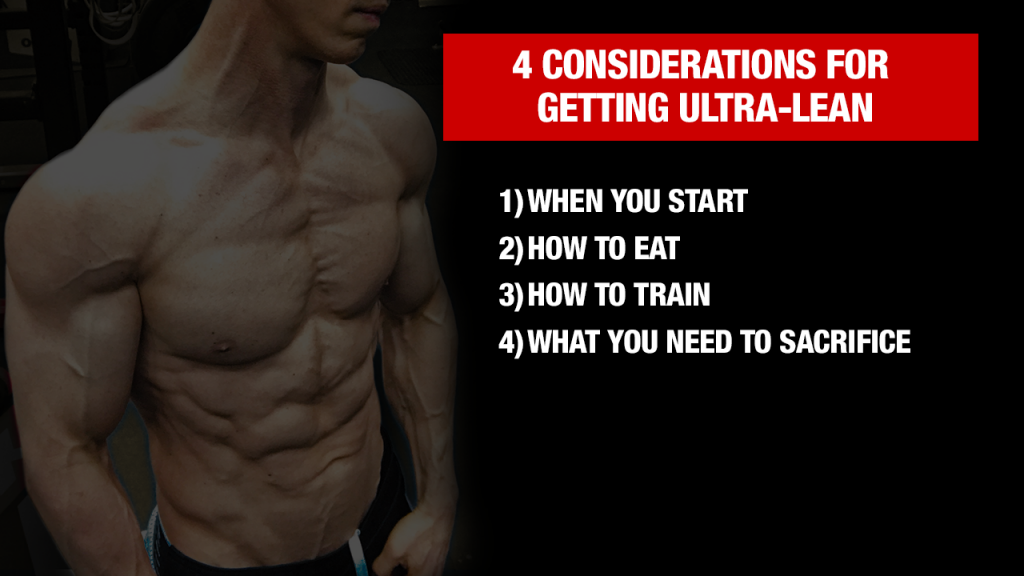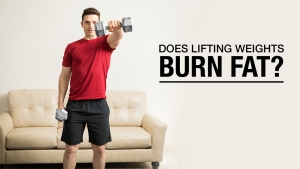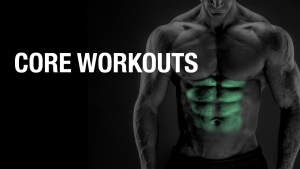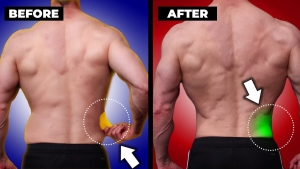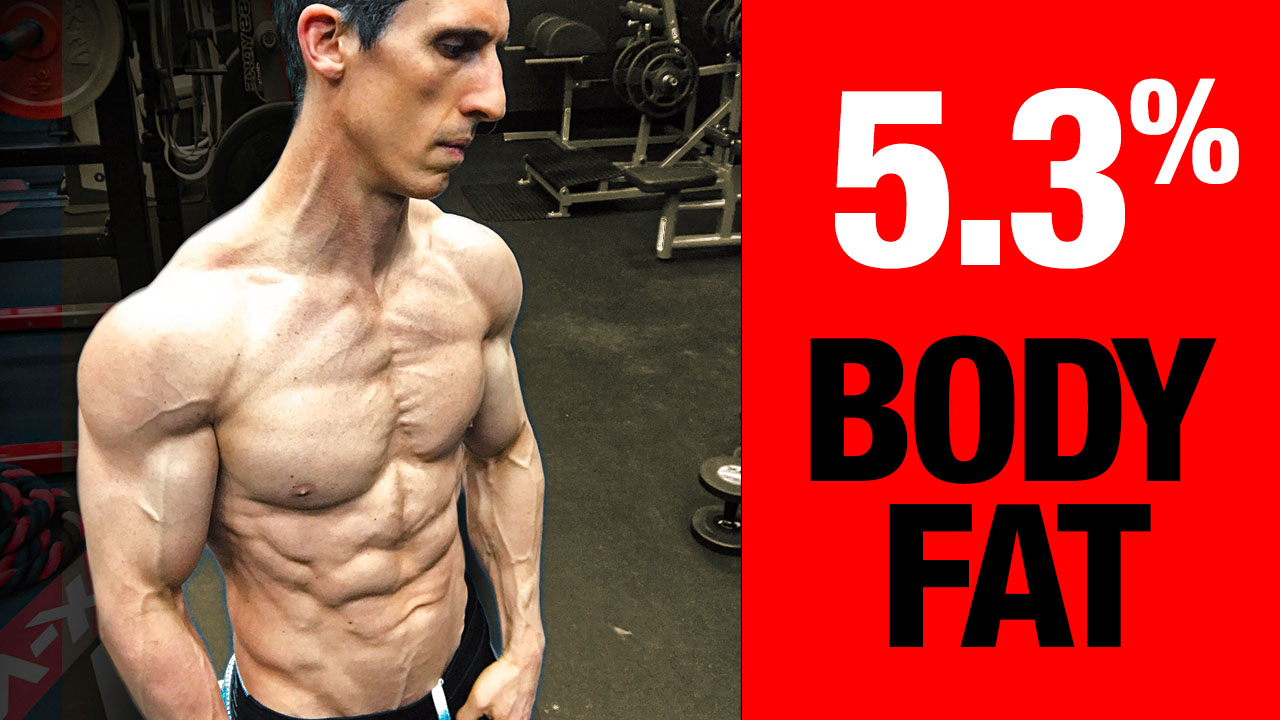
IS GETTING SHREDDED WORTH THE SACRIFICE?
One of the most frequent questions I get is, “What does it take to reach single digit body fat levels?”
A lot of guys aspire to this goal, but before considering it, it’s important you know what it takes to get there.
I’m going to break down everything you need to know, including:
- The best place and time to start
- The right way to eat
- The right way to train
- The harsh truth that most forget to tell you
Each of these elements really makes a difference. But before I do that, I want you to ask yourself a question. Do you really want to be incredibly lean? Is there a reason you’re trying to get shredded?
HOW TO GET LEAN: WHERE TO START
I want you to consider where you are right now in terms of your age, fitness experience, and body composition.
Because this is going to play a huge part in how difficult it is to get lean.
If you decide to jump into fitness and get lean for the first time in your life in your 30s, 40s, or 50s, it’s going to be that much more challenging for you to achieve an insane level of leanness.
In other words, the longer you wait, the harder it will be. I’m not saying it’s impossible, but it is going to be a tough road.
And there are two reasons for that: habits and hormones.
BUILDING GOOD HABITS EARLY
If you started trying to be muscular and lean way back in your teens, getting lean is going to be a lot easier. Your body is already familiar with the foundation of what you’ll need to build on in order to get shredded.
What’s more, the earlier you start training, the earlier you’ll start to adopt healthy habits that allow you to get on that path to getting lean.
Now, if you didn’t start early with good habits, there’s a good chance that you’ve accumulated some other habits.
A lot of times, maybe some not so good habits.
And it’s really hard to replace the ingrained and not-so-good habits that you’ve been doing for 30 years with brand new habits that are required to get to that level of leanness.
THE HORMONAL ADVANTAGE
When you start training earlier in life, you give yourself an advantage hormonally. Levels of growth hormone will be higher, supporting muscle growth and prompting your body to use more fat for fuel.
The earlier you do this, the more you can take advantage of the benefits that this hormonal environment provides you. Not the least of which is a better opportunity to add more lean muscle mass to your frame.
Again, it isn’t impossible, but the guys who start later on in life will find it a lot more difficult.
This shouldn’t discourage you from wanting to get lean if you’re starting later in life.
You can certainly get to a level of leanness that looks incredible with dedication and hard work.
HOW TO EAT FOR A LEAN BODY
Next, I think you really need to hear the truth about eating for lean body mass.
What you decide to eat is the most important factor when it comes to lowering your body fat levels enough to reveal those hard-earned muscles (especially those abdominal muscles).
Eating is everything, but what should you eat to get lean?
You’ve got a lot of options these days and most revolve around some style of dieting.
This is both good and bad.


It’s great because you have so much variety and if you find a special diet that works for you, that’s fantastic.
But the vast majority of diets are meant for short term gains. Why is that?
Trendy diets where you need to exclude a certain macronutrient, limiting carb intake for example, are unnatural. This means they will be more difficult to sustain over the long-term.
You see it all the time. People start a popular diet (like a very low carbohydrate diet or a calorie restricted diet) and 30 days later, they jump off of it. The diet is either too difficult to keep up with, energy levels have crashed because of low carbohydrate intake or too few calories per day, or the person stopped seeing those initial fast results.
If you want to get lean and shredded, you need to choose a diet or way of eating that you can do forever. This needs to be a lifestyle that you can follow.
You need the consistency to not just get to the low levels of body fat, but to be able to maintain them.
Personally, I recommend focusing on all three macronutrients: lean proteins, healthy fat intake, and high-quality carb intake. If I had to choose one of these to be the focus of building lean muscle mass, it would be protein intake. Protein is the main building block for muscle tissue. Calories from protein will be important for muscle growth but also to avoid catabolic breakdown of muscle tissue. Generally, if you’re looking to build lean body mass, it’s recommended that you eat about .75 grams of protein per pound of body weight per day. For example, if you weigh 150 lbs, that would mean about 112 grams of protein per day. Adequate protein intake will also keep you full and help you from overeating less nutritionally dense foods like processed carbohydrates.
From there you’ll want to choose healthy carbs for energy including whole grain sources of starchy carbs like whole wheat and other grains and sweet potato. You’ll also want to include as many fibrous carbs as you can, which are fruits and vegetables. Finally, fats should generally be incidental: used to cook your food or as a garnish as in the case of avocado.
HOW IMPORTANT IS IT TO TRACK CALORIES?
Sure, calories are important, but it’s more important to focus on consistently good eating habits than creating diets around myths like one pound of body fat equals 3,500 calories.
With that said, I think tracking calories can be really helpful for most of you. If you’ve never tried getting shredded before, tracking calories will help you to understand portion control and how many calories are in the foods you eat.
It will also help to steer you towards better healthy food choices.
Here are some basic tips to keep in mind when it comes to calorie intake and counting calories.
And I can’t stress this enough: start with the basics! It can be easy to overwhelm yourself with calorie goals, especially when it comes to counting calories or tracking your meals.
Each macronutrient has a different number of calories per gram.
- One gram of protein has four calories
- One gram of carbs has four calories
- One gram of fat has nine calories
Of the three macronutrients, I’d say that your protein intake is the most important for building muscle without sacrificing muscle mass in a calorie deficit.
In the beginning, I’d say don’t worry so much about extra calories as choosing the right healthy foods. By focusing on the right choices, you’ll naturally start to eat a lower calorie diet.
Your diet should complement the calorie burn you get from your training. The two should work together, the diet fueling your training and your physical activity burning more calories.
HOW TO GET SHREDDED: THE TRAINING
Why is it people assume that if you’re lean, you must lift a lot of light weights with high reps?
I don’t know where this idea came from, but it’s still commonly believed. The truth is that’s not what happens.
Yes, lifting light weights with high reps is important but it’s one part of the solution for building lean muscle mass.
Getting lean isn’t as much about weight loss as it is maximizing the amount of muscle tissue that you carry on your frame. In order to do that, you need to explore all the opportunities in your regular strength training to get there including compound exercises.
You would never follow just one training methodology like high weight and low reps in your exercise plan.
There are three elements to training that should be in your workouts for getting lean:
PROGRESSIVE OVERLOAD AND HEAVY WEIGHTS
First, I’d say the bulk of your strength training workouts each week should focus on progressive overload with compound movements.
The idea here is lift progressively heavier weights on popular types of exercises like squats, deadlifts, and bench presses.
This is going to allow you to maximize muscle mass.

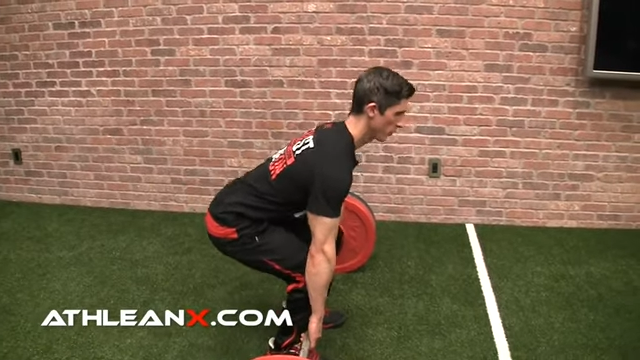
LIGHT WEIGHTS, HIGH REPS
Next, you want to include exercises in your strength training routine where you lift lighter weights with higher repetitions. You can also perform body weight exercises with high rep counts.
This type of weight training creates a different kind of metabolic stress.
Paired with the progressive overload, these two types of lifting are ideal for promoting hypertrophy or muscle growth. Training to muscle failure is another great technique for building the muscle fibers.


FOCUS ON THE ECCENTRIC LIFT
Finally, you should focus on the eccentric portion of the exercise.
The eccentric stress and overload can create a separate type of tissue damage that sparks hypertrophy in the long run.
All in all, you need to make sure you’re looking for every opportunity to introduce different kinds of stresses into your training program to get the best benefit when it comes to adding lean muscle.

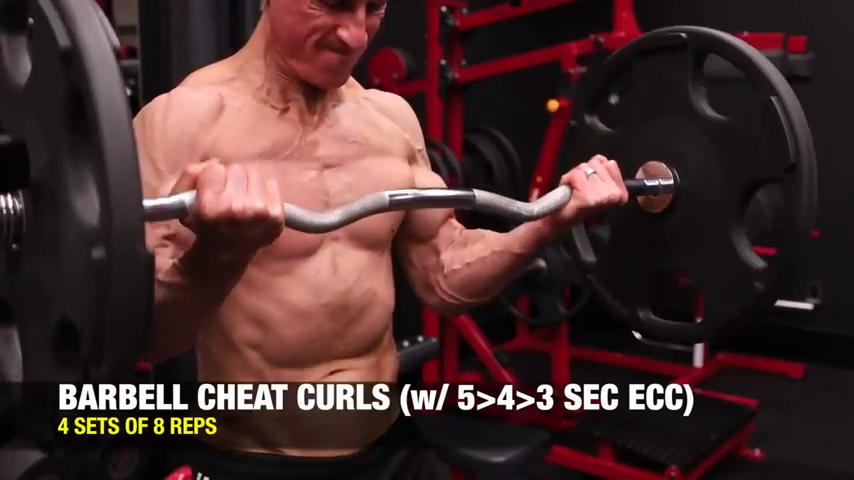
STEADY STATE CARDIOVASCULAR TRAINING
To wrap up the training for lean muscle, let’s talk about steady state cardio.
Steady state refers to low intensity and long duration aerobic training like jumping on an elliptical at your local gym and doing that for about an hour.
Just like training with light weights, many people still assume that the bulk of your regular exercise routine should be focused on this type of aerobic exercise.
Guess what, guys. You might be shocked to learn that I do zero steady state cardio. Zero.
I’m not saying you have to do the same. That’s more an admission, not a recommendation.
Does steady state cardio have its benefits? Absolutely. Should it be done for the benefit of your own cardiovascular health? Absolutely. But it is not a requirement to get ultra-lean.
With that said, athletic conditioning and high-intensity interval training (HIIT) play a very important role in my workouts.

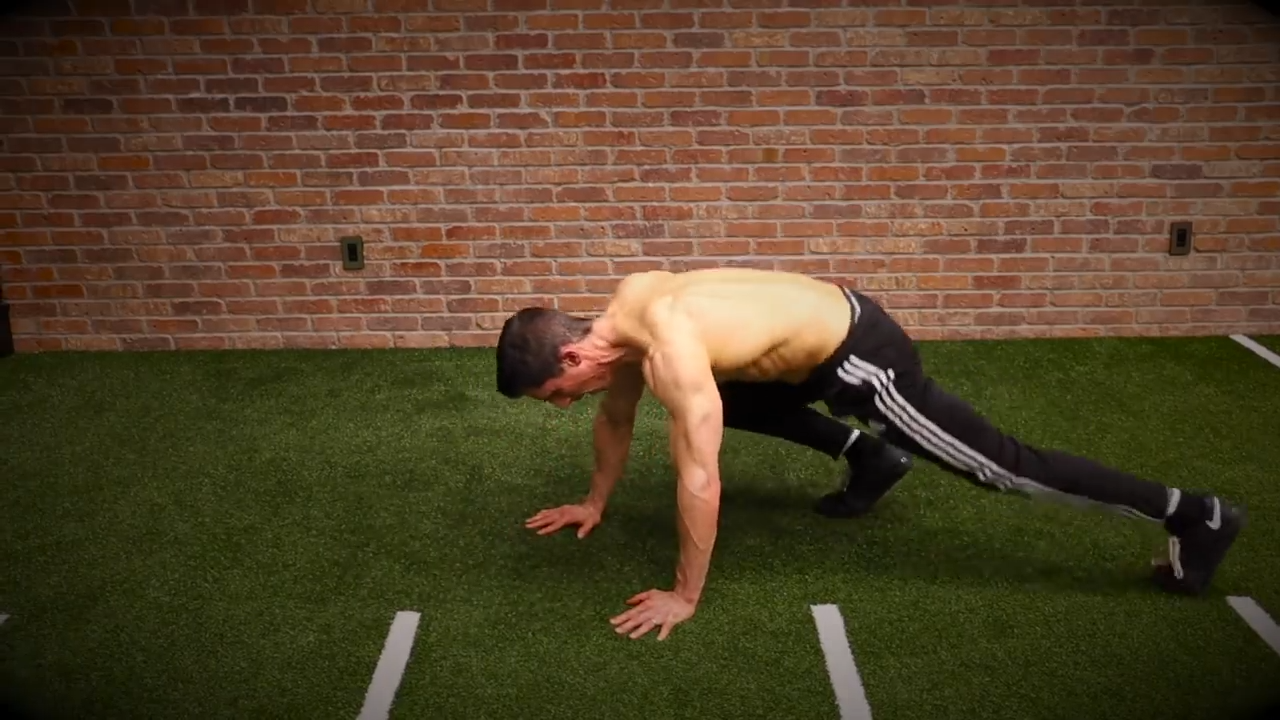
High intensity training days are quick and fast-paced with short rest breaks.
They take about 15 to 20 minutes where old school steady state cardio can take an hour or more.
What I want you to take away from this is that you don’t HAVE to do steady state cardio to get lean. There are other ways to get ripped.
THE HARSH TRUTH ABOUT GETTING LEAN
The question you need to ask yourself is, “How much do I want to sacrifice?”
Because there are sacrifices to this lifestyle, and they come in many forms.
DIET: SWEETS AND ALCOHOL
Sweets need to go.
I think it’s well documented that I don’t eat sweets anymore.
Sure, I’ll have my once-a-year carrot cake, but overall, I’ve cut sweets from my diet and focused on creating a healthy meal plan that I love.
What about a cheat day? Instead of cheat days, if it helps you stay on track, consider having a couple of cheat meals per week, but don’t overdo it.
Alcohol’s another one. You’ll probably have to cut out or cut down on your alcohol consumption.
Even with just a few drinks… a little bit of alcohol and you’re consuming a ton of unhealthy and unnecessary calories that are going to wind up taking a toll on you and your body fat levels.
Water will become a new friend in place of calorie-heavy beverages.
THE LEAN LIFESTYLE
Aside from your diet, you need to get the other things right.
Rest days are critical. You need to make sure you’re recovering and getting no less than seven hours of sleep each night.
Hydration is critical, especially again when you’re at low body fat levels.
Supplements will be a huge help next to your meal plan, especially whey protein powder.
ARE YOU READY?
So, are you ready to make those sacrifices? Maybe you’re not.
Maybe you’d rather enjoy your social life than walk around with single-digit body fat levels, and that is okay.
I’m going to bring this full circle and tell you to identify your goals.
Again, WHY do you want to get this lean? Why is it important to you? If you don’t find your why, I can guarantee that you won’t want to make the sacrifices that are necessary to drop your body fat levels.
You need to take all the elements seriously and stay consistent with them.
So, is the lean lifestyle right for you? Only you can answer that question.
Getting very lean is going to take consistency, some lifestyle changes and possibly some sacrifices.
Whether your goal is single-digit body fat levels or just getting leaner than you currently are, you need a plan to get there.
Our ATHLEAN-X programs are designed to help you reach your size, strength and fat loss goals. Find the program that’s best-suited to your needs.

- If you want to get a lean, ripped body and keep it year-round, there are no secret shortcuts or gimmicks.
- First, you need to understand that the later in life you start this journey, the tougher it will be. It’s not impossible but you’re taking the longer and bumpier road.
- The earlier you start your fitness journey, the better off you’ll be. Through the good habits you build, it’ll be easier to maintain the discipline required to get this ripped.
- How you eat is going to be the absolute most important part of how lean you look. There is nothing that can overcome a bad diet when it comes to getting ripped.
- It is never a good idea to adopt an eating style that requires you to eliminate or drastically cut down one of the three main macronutrients from your diet. Instead, it is much healthier and successful long term to consume all three but to make wiser food choices from within the categories.
- When it comes to training, there is no truth to the myth that you should ONLY train with light weights and high reps to get ripped.
- Instead, focus on all three systems: progressive overload workouts with compound movements, eccentric lifting, and workouts with light weights and high reps.
- You will need to make lifestyle sacrifices to get this lean. You’ll have to cut down or eliminate sweets and alcohol. You’ll need to get at least seven hours of sleep. And you should supplement your diet. Is this what you want to do? Only you can answer that.

Jeff Cavaliere M.S.P.T, CSCS
Jeff Cavaliere is a Physical Therapist, Strength Coach and creator of the ATHLEAN-X Training Programs and ATHLEAN-Rx Supplements. He has a Masters in Physical Therapy (MSPT) and has worked as Head Physical Therapist for the New York Mets, as well as training many elite professional athletes in Major League Baseball, NFL, MMA and professional wrestling. His programs produce “next level” achievements in muscle size, strength and performance for professional athletes and anyone looking to build a muscular athletic physique.
















